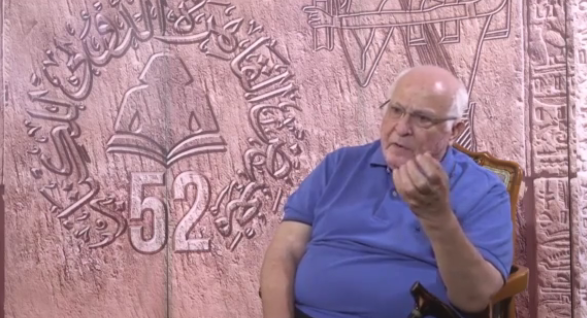On Saturday, legendary Egyptian artist Mostafa Al Razzaz set an impressive timeline for the progression of Egyptian arts through history during his seminar streamed at Cairo International Book Fair (CIBF) platform.

He started his talk by expressing the beauties of ancient Egyptian arts and how they gave the care of using various kinds of stones to add persity of colors. Next, he explained how Ancient Greeks and Greco-Romans were influenced by the ancient Egyptian arts.

The iconic painter said that when Alexander the Great invaded Egypt, he was impressed by the huge stone buildings the Ancient Egyptian established, and he recorded his observations in a letter sent to his mother.
These early observations and the coming of the Greco-Romans to Egypt contributed to sending the Egyptian authentic sculpture style and technique to the Greek civilization.

He highlighted that Greco-Romans started establishing temples and monuments following the Ancient Egyptian style, then, a hybrid combination between the Greek spirit, and the Egyptian and Oriental heritage appeared to form what's known as "Hellenistic Civilization" that centered in Alexandria.
The artist also underscored that there was a vast difference between Egyptian women who had more authority and rights than Greek women. So, Greeks imposed rules for Greek women that were different from the ones imposed for Egyptians.

Moving to the influences of Egyptian arts in the Coptic period, Al Razzaz reflected that the Coptic arts were a combination of various cultures including Ancient Egyptians, and Hellenistic. Those concepts were deeply observed in the Coptic language.
During the Islamic period, Muslim builders depended on various features such as simplicity, authenticity, and persity of colors through establishing Muslim monuments and mosques.

In the same context, El Razzaz highlighted that the Ottoman period was the worst period Egypt faced, especially arts, and this period of the fall of the Egyptian civilization ended by the French military presence in Egypt.
He underscored that the French civilization left a deep mark on Egyptian modern art. Next, the modern arts in Egypt faced a new wave of European influence after the opening of the first Fine Arts school in Egypt early 1900s.

After that, he narrated that the first generation of Fine Arts School graduates faced a crisis called the "epistemological rupture." It means that Egyptian artists started to adapt the European identity and erasing their original one. However, this mood rapidly changed on the occasion of the 1919 Revolution as it represented awake for the Egyptian nationality and identity.
Therefore, artists like Mahmoud Said, Mahmoud Mokhtar, and Ragheb Ayad started to focus on reintroducing the Egyptian identity in their artworks.

Finally, he talked about his career and influences, he expressed that he traveled to unknown spots in Egypt and was influenced by their local and folk art patterns, alongside, observing the development of art movements in Europe through books he read at Saad El Khadem library.
Al Razzaz revealed that he touched his arts' spirit since his childhood, and he faced harsh opposition from his family, but he worked hard to achieve his dream.

The artist added that he paints every day, and tries to reflect new ideas through his paintings, asserting that he is dedicating his life to arts and it is the biggest gift he has.












